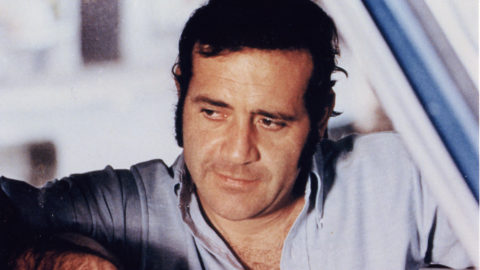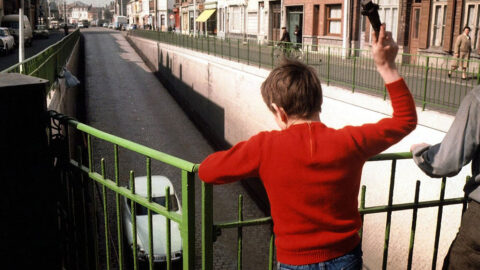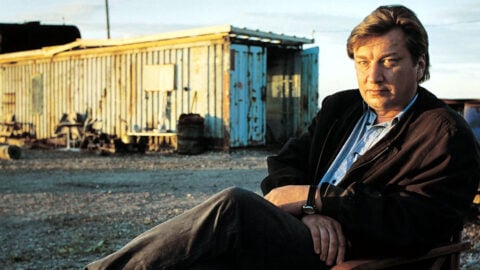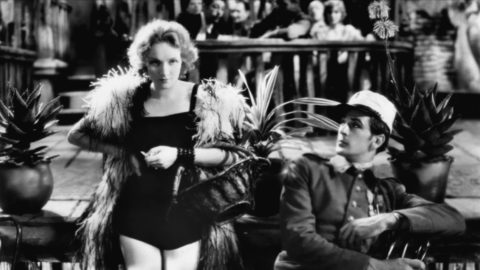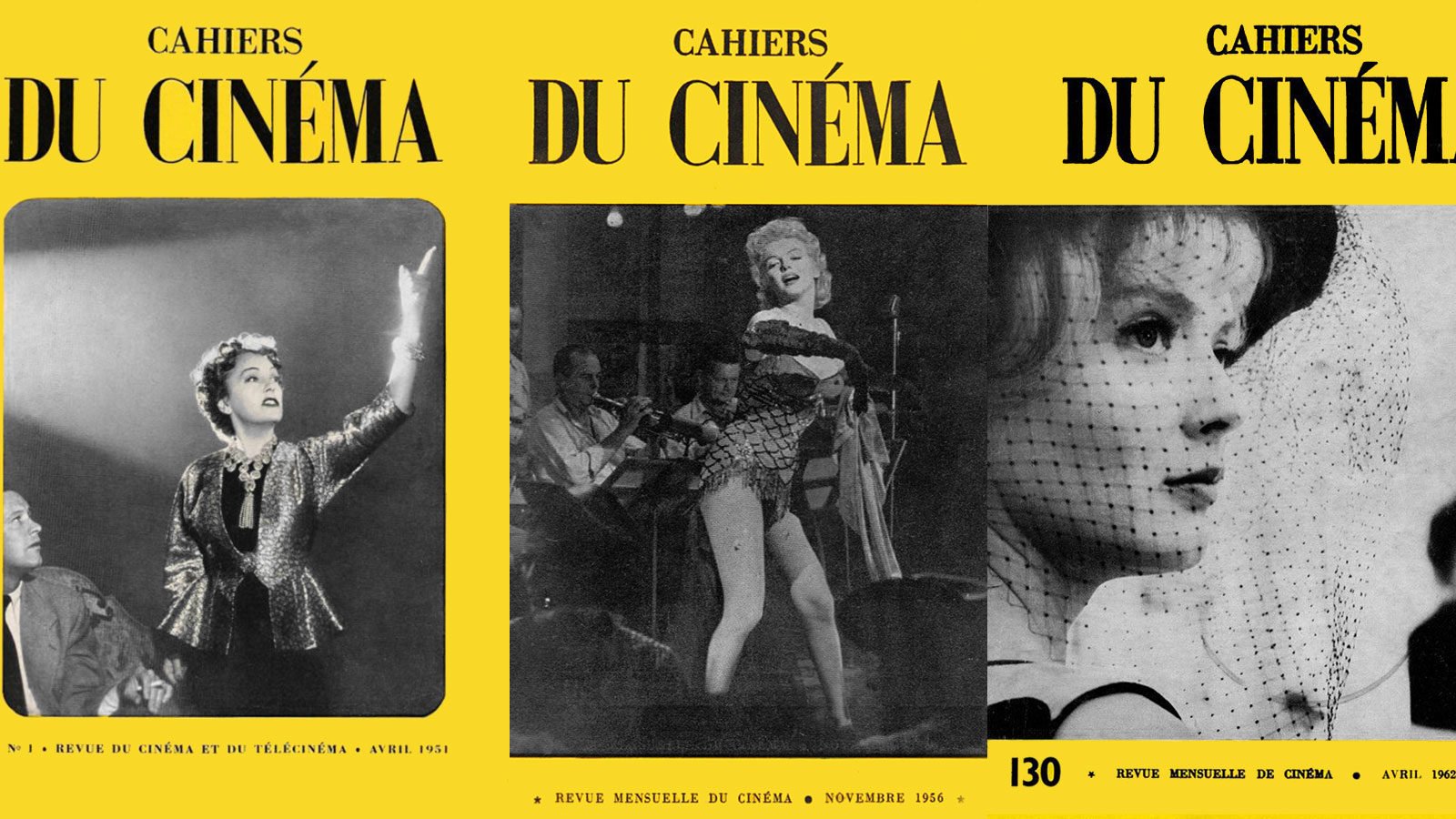
Cahiers Back in the Day
The first issue of Cahiers du Cinéma was dated April 1951 and featured on its cover a black-and-white still of Gloria Swanson, bathed in the beam of an unseen movie projector, from Billy Wilder’s Sunset Boulevard.
The choice seems ironic now, given that neither Wilder nor the silent cinema as embodied by Swanson remained a Cahiers favorite for very long.
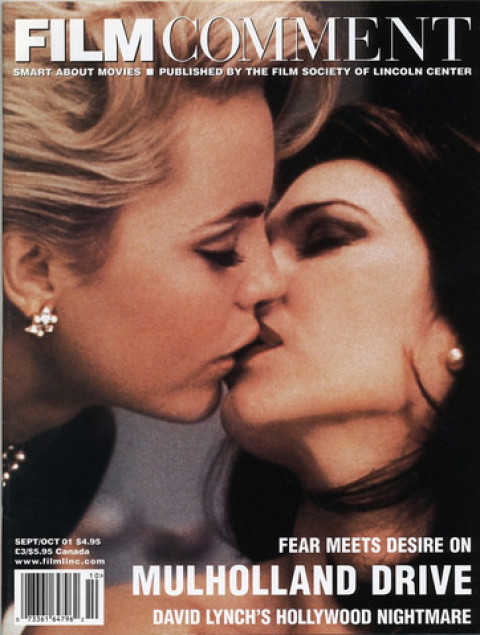
Though Wilder was much admired by the magazine’s founders—Jacques Doniol-Valcroze, Lo Duca, and André Bazin—his work was typed as too literary by the generation of “Jeunes Turcs” who quickly took over the magazine. Under the leadership of one Maurice Schérer, who became better known under his pseudonym, Eric Rohmer, the group included François Truffaut, Jacques Rivette, Claude Chabrol, and Jean-Luc Godard—the core of the movement that, when these young writers re-invented themselves as filmmakers, became known as the Nouvelle Vague.
No doubt, it was the instant notoriety and almost universal acclaim that greeted the New Wave filmmakers as each, in turn, made their debut features in the late Fifties that cemented the magazine’s reputation. Cahiers became known as an almost mythical breeding ground for new talent, a reputation that extended far beyond the directors of the New Wave to include such contemporary talents as André Téchiné, Leos Carax, and Olivier Assayas, all of whom first ventured into print as Cahiers critics.
But the magazine’s lasting impact is due less to the talent it bred than the ideas it hatched and successfully implanted in film culture. Though there were many other French publications of importance at the time, including most conspicuously Positif and Presence du cinéma, it was the polemic launched and sustained by Cahiers that was responsible for installing many of the basic concepts of postwar film criticism.
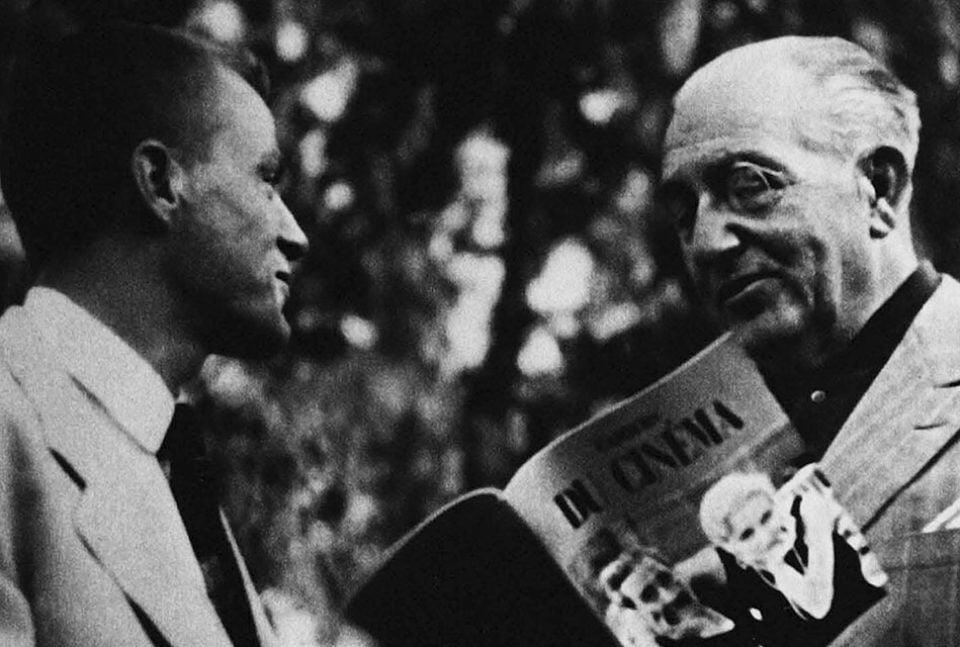
Fritz Lang
The revolution came in stages, all of which are documented with detail and passion in Antoine de Baecque’s two-volume Les Cahiers du Cinéma: Histoire d’une revue, published for the magazine’s 40th anniversary in 1991.
It was the intent of Bazin and Doniol-Valcroze (Lo Duca soon left the publication, defecting to Positif) to continue the more scholarly, less impressionistic style of criticism pioneered in France by their late friend and mentor Jean Georges Auriol. Doniol-Valcroze, the magazine’s editor from 1951 to 1957, shared Bazin’s taste for the realist cinema of Orson Welles and William Wyler (or at least the new standard of realism made possible by Gregg Toland’s experiments in deep-focus photography). Like Bazin, he was suspicious of the leftist orientation and nostalgia for the “golden age” of silent film that dominated the old guard of French criticism. For Bazin and Doniol-Valcroze, movies were an ongoing adventure, not something frozen in time at the moment of Sergei Eisenstein and Jean Epstein.
This was already a radical notion, but it took the “Hitchcocko-Hawksiens,” as the Rohmer-Truffaut generation was soon nicknamed, to push the notion to its then-shocking extreme. For these young critics, Hollywood was far from being the enemy of all art and commitment it was commonly held to be; on the contrary, it was a center of creativity on a par with Elizabethan England. Behind the blatantly commercial work of such filmmakers as Alfred Hitchcock and Howard Hawks, the young critics saw thoroughly modern artists working to express themselves in a thoroughly modern medium.
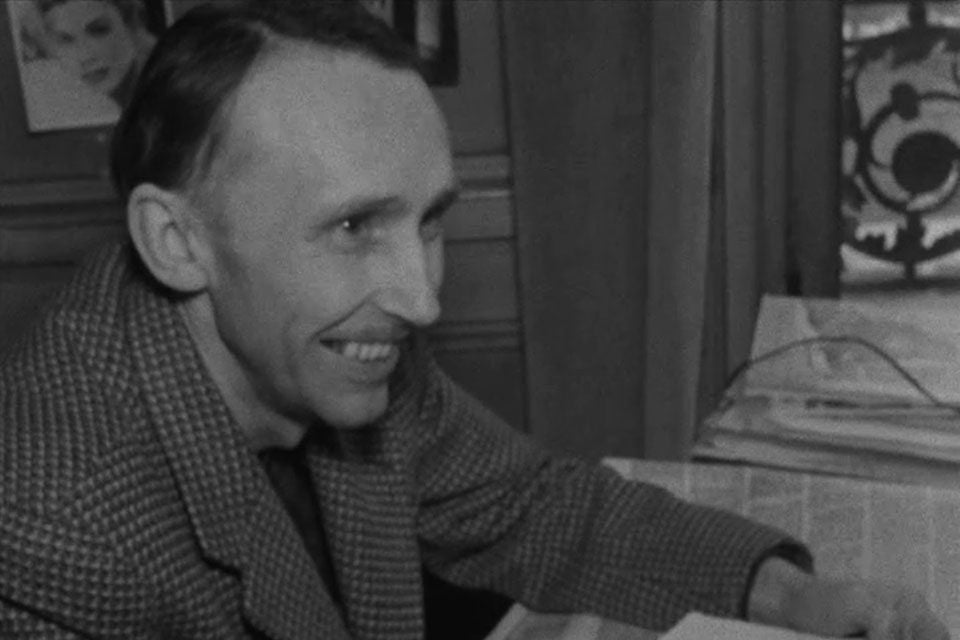
André Bazin at the Cahiers offices in La Sonate à Kreutzer
Today, when critical studies of Hitchcock fill the shelves of bookstores and libraries, it’s hard to imagine a time when taking Hitchcock seriously was tantamount to a public declaration of insanity. At the time, however, both Bazin and Doniol-Valcroze looked upon their younger colleagues’ enthusiasm as youthful folly—surely, there could be little in the work of such a manifestly trivial entertainer to equal that of Renoir or the Italian neorealists.
But Rohmer, Truffaut, and their compères—Rohmer was the oldest, at 31; Truffaut was a preposterous 19—began accumulating the evidence to back up their hunch, first for Hitchcock, then for Howard Hawks, and eventually for a whole range of “auteurs” who came to represent the Cahiers taste: Robert Aldrich, Nicholas Ray, Frank Tashlin, Fritz Lang, Anthony Mann, Budd Boetticher, and even a few non-Hollywoodians, supremely including Jean Renoir, Roberto Rossellini, Kenji Mizoguchi, Max Ophuls, and Jean Cocteau.
These men (it was left to the MacMahonists, an auteurist splinter group who emerged in the early Sixties, to introduce the first female auteur, Ida Lupino) were “auteurs” not by virtue of the fact that they created their films from top to bottom. In the case of many of the Hollywood directors, they did not even have a free choice of the scripts thrust upon them, and had to turn their films over to others for editing. Instead, they were able to express themselves through recurring thematic elements, distinctive ways of building characters, and, above all, through the deployment and movement of actors and objects within the time and space of the shot.
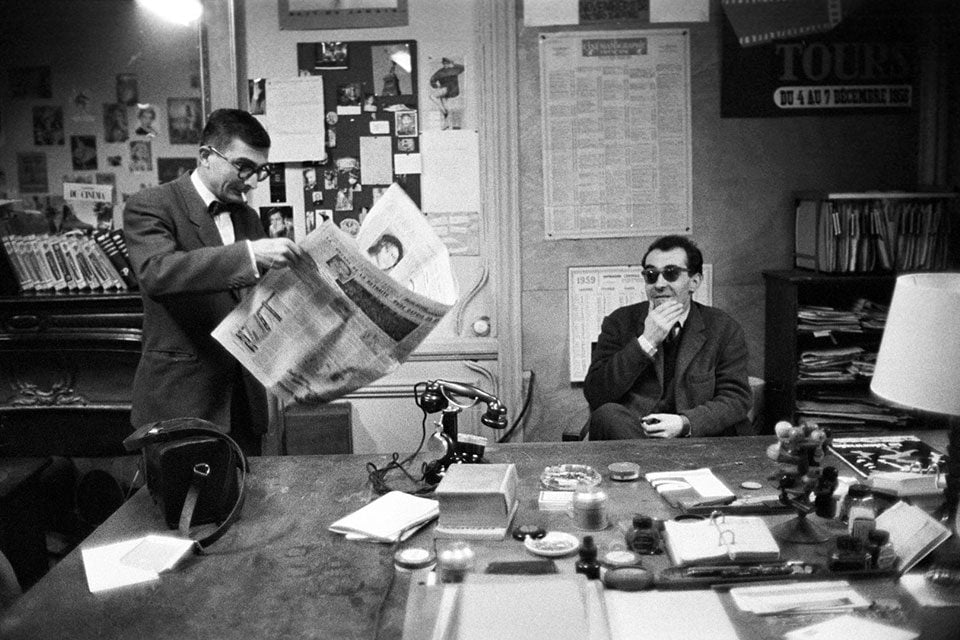
Claude Chabrol and Jean-Luc Godard at the Cahiers offices in 1959
This latter notion, codified as “mise-en-scène,” is at once the most mystical and the most practical of Cahiers’ contributions to criticism. Mystical, because of its foundation in André Bazin’s deeply held Catholicism, in which mise-en-scène was held to be a kind of emanation of the director’s soul. Practical, because it gave a very useful name to something that had never been named before: the mysterious X factor that made movies different from literature, painting, photography, and the theater. Movies were not a bastard art (though Bazin and his followers continued to conceive of them as gloriously “impure,” mixing elements from all the arts), but a major one with a unique component, one that a true auteur could mold and manipulate into a personal expression that no studio chief could eradicate or repress—being the stuff of the cinematic experience itself.
Mise-en-scène was something that ran across an auteur’s entire body of work, figuring as distinctively in his major films as in his minor, flawed, or failed efforts. Thus, even a patently unsuccessful Nicholas Ray film such as Hot Blood could be shown to be full of authorial moments, when the director succeeded in snatching a second of sublimity from the surrounding morass of studio-imposed mediocrity. (The Cahiers notion of the auteur owes a clear debt to the essayist and filmmaker Alexandre Astruc, whose 1948 article in L’Écran français titled “Birth of a New Avant-Garde,” advanced the idea of the caméra-stylo. For Astruc, the camera was a means of expression as supple and personal as the writer’s pen.)
Rohmer called this part-over-whole approach “la critique des beautés”—the appreciation of flashes of beauty. Truffaut developed it in his own way, into his concept of “the privileged moment,” as when actors or directors revealed themselves inadvertently, unconsciously through a gesture or a tic. Thus, the critical discussion was moved away from the search for individual masterpieces, and toward reclamation of the day-to-day filmgoing experience.
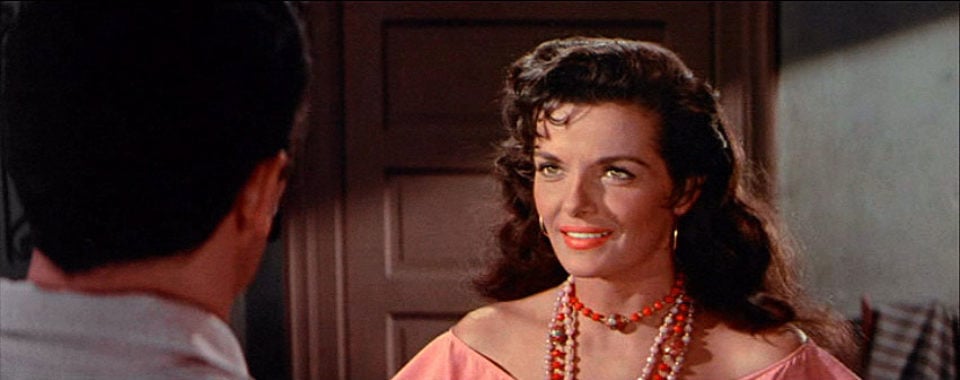
Hot Blood
For the young Cahiers critics, as for most of the French “cinémanes” of the day, filmgoing was a full-time commitment, requiring attendance not only at the first-run theaters on the Champs Elysées but at every neighborhood grind house (then filled with the American B-movies that particularly caught Godard’s fancy) and every program at Henri Langlois’ Cinémathèque Française (where the eccentric Langlois regaled his young acolytes with silent and early sound films from his own wide-ranging collection). This constant filmgoing was a way of “living” the cinema, in contrast to the old-guard critics who would see two or three films a week at private press screenings.
It was a contrast of which the young critics were fiercely proud. They would be the first generation of obsessive film buffs, memorizing lists of credits the way American kids would memorize batting averages. At a time when film scholarship was still a fuzzy notion, and most professional historians, including the widely respected Georges Sadoul, had to rely on their fading first-hand memories of films in the absence of easily available prints, the insistence of the younger critics on factual accuracy and thorough research was nothing short of revolutionary.
The defining moment in the early history of Cahiers du Cinéma arrived with issue number 31, published in January 1953. An article by Truffaut, ingenuously titled “Une certaine tendance du cinéma française,” offered a violent attack on the French film establishment of the day. Truffaut tore into the leading lights of French cinema—Claude Autant-Lara, Christian-Jacque, Jean Delannoy, Yves Allegret, and, in particular, the screenwriting team of Jean Aurenche and Pierre Bost—for being excessively faithful to the literary sources of their films. For Truffaut, the “qualité française” represented by such films as La Symphonie pastorale, Devil in the Flesh, and Forbidden Games was nothing more than a matter of transposing (and hence, betraying) novelistic values from the page to the screen, a question of a “psychological realism” that had nothing to do with the expressive qualities specific to the cinema, dressed up with excessively tasteful lighting, elaborate production design, and self-consciously poetic dialogue.
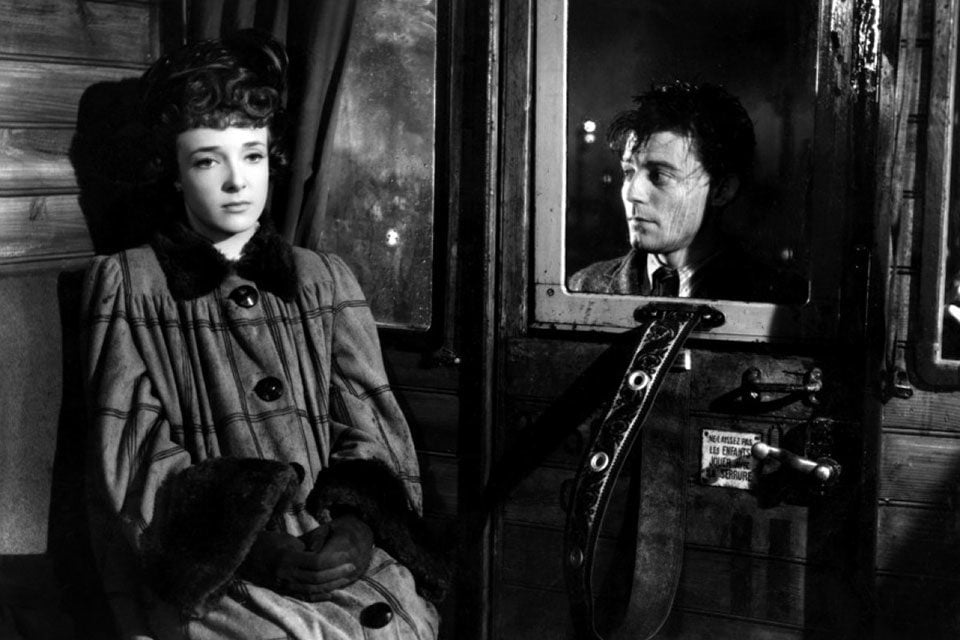
Devil in the Flesh
“La qualité française” (the phrase quickly became a term of approbation) is, of course, still with us, and is still winning Academy Award nominations and ecstatic reviews—not only for French films like East-West and The Horseman on the Roof, but for much of Miramax (Shakespeare in Love, The Cider House Rules), virtually all of Merchant Ivory, and the vast majority of the British cinema that makes it to these shores. But if Truffaut did not succeed in stamping out the scourge of “quality,” he did cast the notion into deep disrepute—some say, cynically, in order to undermine the reputations of the elder French filmmakers and prepare the way for himself and his fellow Cahiers critics to emerge, just a few years later, as the Nouvelle Vague.
Rereading Truffaut’s article today, one is struck by how moralistic and conservative it is. One of his main complaints against Aurenche and Bost is that they are not respectful enough of the clergy. He also objects to the use of vulgar language, nudity, and excessive sensuality; at one astonishing moment, he denounces The Wages of Fear for “the pederastic relationships” among the main characters. This reactionary tendency represents the dark side of Cahiers in the Fifties, along with a refusal (though it does not appear in Truffaut’s initial piece) of all political comment. Antoine de Baecque writes that, in reading the entirety of Cahiers for the decade, he found only one reference to the Algerian war, and that as an ironic aside when one Cahiers writer was called up for military duty. Political engagement became the province of the left-leaning Positif, the arch-rival to Cahiers founded in 1952 by Bernard Chardère.
Whatever the merits of Truffaut’s case, the article did initiate a new era—the era of criticism as a contact sport. Polemics became the order of the day, as the young turks of Cahiers struck out against the established critics and the respected filmmakers of the day, often in highly intemperate language (when, many years later, Truffaut put together a collection of his criticism under the title The Films of My Life, he carefully omitted any trace of the personal attacks that had made his early reputation; he was no longer willing to risk his international standing as the embodiment of Gallic wisdom and tolerance). The magazine’s aggressive stance became codified as “la politique des auteurs”—a policy, essentially, of being for some filmmakers (Hitchcock, Hawks, Rossellini, Renoir) and against others (including several—Wyler, Huston, Wilder—who became Positif favorites).
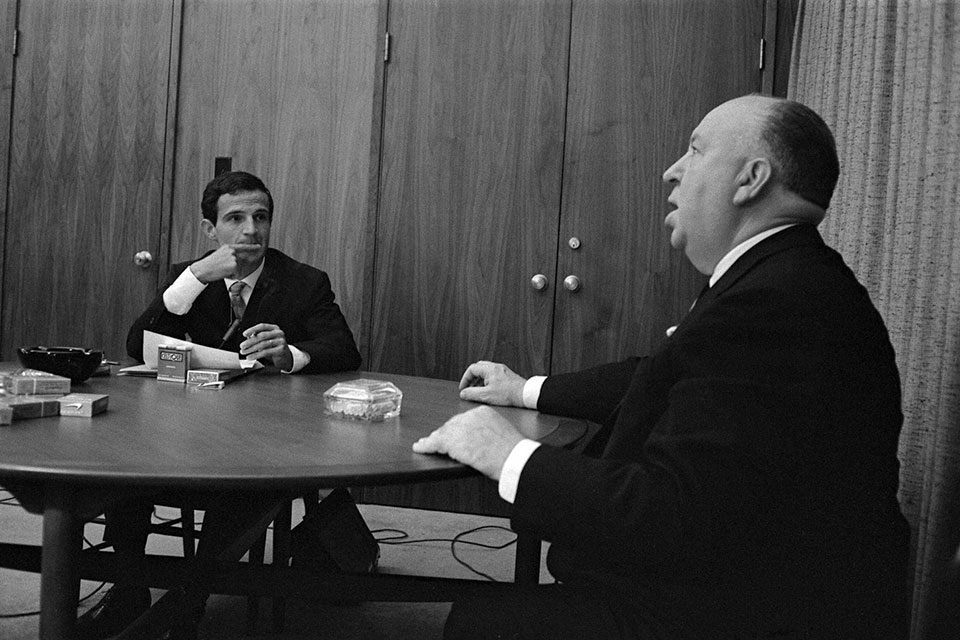
François Truffaut and Alfred Hitchcock in 1962
Eventually, Eric Rohmer replaced Doniol-Valcroze as the editor of Cahiers, a victory for the young guard over the old. With the “politique des auteurs” firmly ensconced, the magazine promoted its positions through an innovative use of lengthy interviews (made possible by the development of portable tape recorders). New auteurs were added to the list, as Cahiers cautiously ventured beyond the Paris-Hollywood axis: Kenji Mizoguchi from Japan, Ingmar Bergman from Sweden.
By the late Fifties, many of the most active Cahiers writers were leaving the magazine to follow their own careers as filmmakers, applying the lessons they had learned from American cinema to the French system of production. The history of the Nouvelle Vague belongs to another article, but clearly the critical concepts pioneered by Cahiers would not have had such an extensive international impact were it not for the mounting reputations of the New Wave directors. It was easy for skeptical British or American critics to dismiss Cahiers’ enthusiasm for the films of Nicholas Ray or Samuel Fuller as the ravings of a few mad Frenchmen. But when the Frenchmen were making movies like The 400 Blows, Breathless, and Les Bonnes femmes, their critical opinions suddenly acquired a new authority.
Cahiers du Cinéma continued (and continues) to evolve. When Jacques Rivette replaced Rohmer as the editor-in-chief in 1963, following a bitter internal struggle, the magazine became more open to modern currents in politics and philosophy. Structuralism made its first appearance in Cahiers through an interview with Roland Barthes in September of 1963, conducted by Rivette and Michel Delahaye. A sudden admiration for Alain Resnais marked the shift of the Cahiers aesthetic away from Hollywood classicism and toward European modernism. Joining the editorial board, Jean Narboni and Claude Ollier introduced a new political consciousness and a new openness toward third-world filmmaking. A host of new critics filled the review, taking the places abandoned by the New Wave filmmakers: Serge Daney, Luc Moullet, André Téchiné, Pascal Bonitzer, Jacques Fieschi. And when May ’68 shook France to its foundations, Cahiers was there, sponsoring the radical congress “Les Etats Généraux du cinéma.”
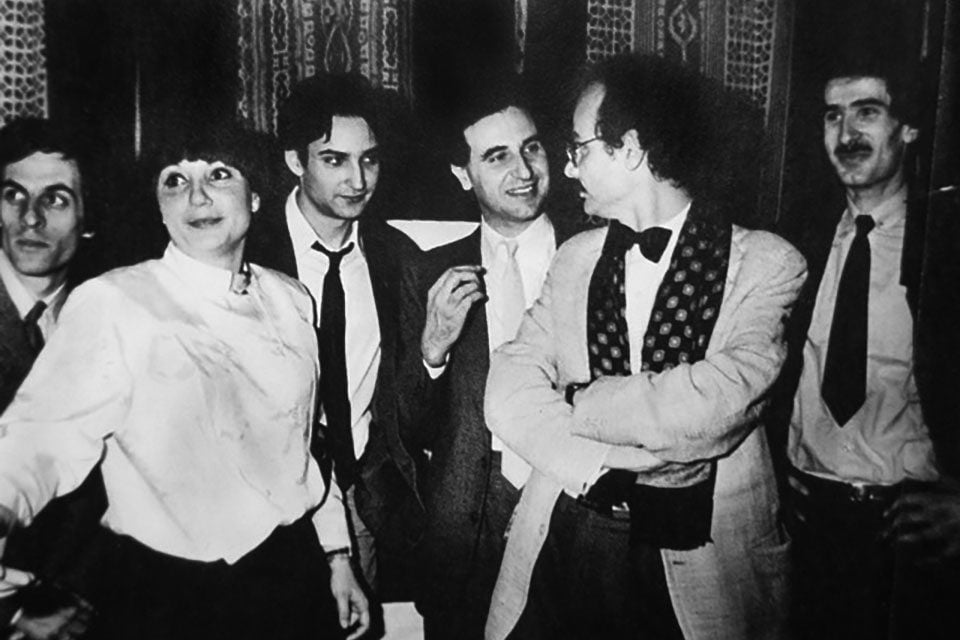
Cahiers 30th anniversary party in 1981, from left to right: Yann Lardeau, Claudine Paquot, Olivier Assayas, Serge Toubiana, Serge Daney and Charles Tesson
The radicalized Cahiers of the early Seventies abandoned the last vestiges of the “politique des auteurs” in favor of a proliferation of theory in which individual filmmakers—dismissed as romantic fictions—had no particular role. Instead, the discussion turned to technique and ideology, and how one determined the other. Althusser and Marx replaced Hitchcock and Hawks as Cahiers icons. In March of 1969, the magazine founded in the Catholic transcendentalism of André Bazin proudly declared its loyalty to “the Marxist science of dialectical materialism.” Photographs were banned, and it would be seven years before a review of a commercial film—appropriately enough, Steven Spielberg’s Jaws—would again appear in the magazine.
In one sense, the Cahiers of the Seventies was more influential than ever. The magazine’s radical-theoretical stance made its way to England, by way of the BFI’s somber Screen magazine, and then to American academia, where it quickly took root. Cahiers-influenced film-studies programs became the means by which French postmodernist philosophy—Foucault, Derrida, Kristeva—entered the American university, where, far more than in its native land, it has prospered and persisted.
And yet it is easier to imagine the contemporary cultural landscape without Jacques Derrida than without Alfred Hitchcock. For all of its romanticism, naïveté and frequent unfairness, the “politique des auteurs” has proven to be uncannily accurate in its choices. By repositioning the entire notion of cinema as an art in itself, by legitimizing the position of the director as a creative force, and by breaking down the barriers between commercial and personal filmmaking, Cahiers du Cinéma contributed to a crucially important cultural shift, one that helped reveal the 20th century to itself.
The post-theoretical Cahiers du Cinéma—led, successively, by Serge Daney, Serge Toubiana, Thierry Jousse, Antoine de Baecque, and Charles Tesson—has gradually re-installed the old gods, and even introduced some new ones: Manoel de Oliveira, Raúl Ruíz, Hou Hsiao-hsien, Youssef Chahine, Abbas Kiarostami, Aki Kaurismäki, Maurice Pialat. A new generation of French filmmakers has grown up on Cahiers: Arnaud Desplechin, Leos Carax, Claire Denis. Any critical enterprise must eventually stand on its record. Cahiers du Cinéma stands tall indeed.



